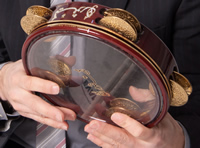Allegro
Roots Music
Adding Arabic tambourine to your composer's bag of tricks
Volume 114, No. 11November, 2014

The Riqq, Arabic tamourine.
I recently presented a percussion demonstration and discussion with string player John T. La Barbera at a seminar at Local 802 entitled “Exotic Instruments, Indigenous Musicians: A New York Composer’s Guide to Writing World Music.” The focus of my presentation was notating and recording indigenous percussion instruments from the Middle East and Egypt. I discovered after listening to the questions after my presentation that the riqq, or Arabic tambourine, is the lesser-known member of the tambourine family. Here are a few quick tips for incorporating the riqq into your next project.
The riqq has a wide range of dynamics and tonal possibilities, and writing for the instrument can either be simple in form or can contain extravagant notation that might be cumbersome for a musician to decode in the studio. In order to write a percussion part that represents the tradition, it is beneficial to study the instrument. Arabic rhythms, also known as “iqa” (singular) or “iqa’at” (plural), are outlined in Michel Merhej’s book “Classical Riqq Technique,” published by Mel Bay. When I assisted Merhej with this book, I helped record examples of Merhej playing the iqa’at and captured the virtuosity of his riqq playing. Listening to these audio examples that accompany the book is one way to grasp the sound and feel of a master playing Arabic rhythms on a handcrafted riqq.
If a composer can communicate and notate the language of “doums and takks” in a basic skeletal form, then the riqq player or percussionist will be able to translate the skeletal rhythm and add in the appropriate embellishments. If the composer calls for variations, then these can also be notated in Western notation with the doums notated on the staff with the stems down, and the takks with the stems up (figure 1). Similar to standard snare or drumset notation, a composer can add accents, dynamics, and rolls to a riqq part. The composer can also dictate the rhythm to a percussionist by using syllables. In addition, the vocalization of doums and takks can apply to other drums such as doumbek and frame drums. This understanding of iqa’at can benefit a composer when writing in the tradition of Arabic music, and indicating the Arabic rhythm in the music helps guide the percussionist through the piece. For instance, the rhythms called Wahda Kabira and Malfuf are essentially the same, yet Wahda Kabira is played at a slower tempo in the classical style and often notated in 4/4 and Malfuf is faster paced in the folk tradition and notated in 2/4 (figure 2). Therefore, indicating the name of the iqa in the score can save time in the studio. Furthermore, compositions can be based on complex rhythms such as the classical Sama’i Thaqil in 10/8 or the Iraqi rhythm Jurjuna (figure 3), and stating the iqa helps the musicians perform the piece of music.

Figure 1: doums and takks

Figure 2: Malfuf rhythm and Wahda Kabira rhythm

The Iraqi rhythm Jurjuna
In my seminar at Local 802, I introduced the concept of skeletal rhythms, which break down the iqa or rhythmic mode to the simplest form. However, there are many percussive colors of sound that percussionists play which ornament the main iqa pattern, and the Arabic tambourine is filled with unlimited tonal and rhythmic combinations. The “zills” or cymbals alone have tremendous character, depending on how you hold the instrument or how you mute it.
There are two primary hand positions that affect the overall sound, known as “classical” and “cabaret” positions. These can affect the dynamics and the color of the sound. A composer can request to play the takk on the cymbals or on the edge of the riqq, or ask to add a roll for an embellishment. The doum can be played as an open tone with the index or the fourth finger depending on the position. The takks can be played by the fourth fingers, with the index fingers applying pressure on the drumhead to change the sound in the classical position. Therefore, Western notation does not reflect the infinite possibilities that one can extract from a percussion instrument like the riqq.
Arabic music is filled with subtleties and nuances that are difficult to reproduce electronically and that can lead to massive editing. It is always best to have musicians record live with indigenous instruments. Yet composers can also experiment by transferring the knowledge of indigenous rhythms to drum set, triggers and keyboards. It can lead the composer to invent infinite rhythmic variations based on the Arabic tradition, and can spark creativity through the adaptation of world rhythms.
Vin Scialla, a member of Local 802 since 2001, has traveled the world teaching and performing music. Inspired by his cultural heritage, combined with sessions with masters of Arabic, Southern Italian and Indian classical music in New York, Scialla records and tours with mandolin virtuoso Snehasish Mozumder, John T. La Barbera, Alessandra Belloni, Nashaz, Neel Murgai and Mission: on Mars. Scialla is pursuing his doctoral degree from Boston University in music education, and has experience teaching at LREI School and Teachers College. He is currently working on a new book on Middle Eastern rhythms, and his sponsors include Sennhesier, Remo and Sabian. His web site is www.LiftoffMusic.com.
